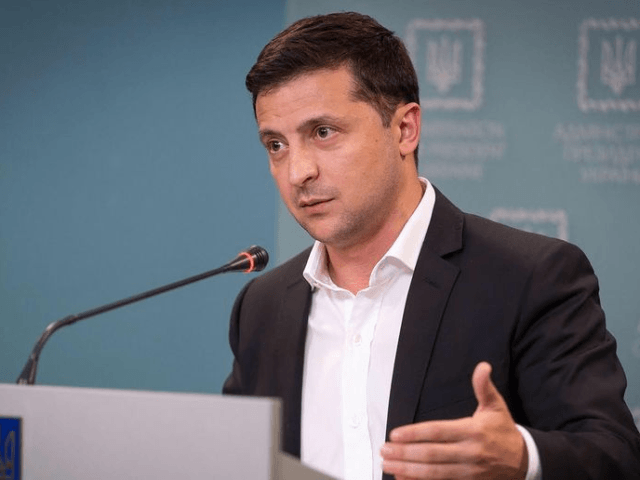Ukrainian President Volodymyr Zelensky traveled to his nation’s embattled Donbass region, where Russia-backed separatists have waged a years-long war to break from Kyiv, on Thursday following the death of a 23-year-old Ukrainian soldier.
Zelensky’s visit follows a week of mounting evidence that the Russian government is amassing tanks and other large-scale military hardware on the other side of the Donbass border. That build-up began after Zelensky signed an executive decree putting into motion a campaign to liberate Crimea, another Ukrainian region, from Russian occupation. Moscow “annexed” Crimea into Russia in 2014 after a brief invasion.
Zelensky has also escalated Kyiv’s campaign to join NATO, which would protect Ukraine by requiring all NATO members to engage militarily if it is attacked – potentially deterring a Russian invasion if an American counterattack is possible.
Crimea, Ukraine 💛💙
ph: leonardi/depositphotos pic.twitter.com/t1lEpKRUoY
— Ukraine / Україна (@Ukraine) March 19, 2021
A statement from Zelensky’s office described his appearance on Ukraine’s eastern border as a “working trip” in which he will “visit the advanced positions, where the regime of comprehensive and permanent cease-fire has been systematically violated recently, and where Ukrainian defenders have been killed and wounded as a result of enemy shelling.” Zelensky also reportedly plans to meet soldiers fighting the Donbass separatists personally.
Donbass consists of the territories of Donetsk and Luhansk, both of which are home to separatist groups who claimed to have seceded, creating the “Donetsk People’s Republic” and “Luhansk People’s Republic,” in May 2014. Neither “republic” has gained any widespread recognition of its alleged sovereignty.
A nominal ceasefire had existed, with Russia’s blessing, in the region for a little less than a year until the Russian side refused all proposals to extend it past April 1. Ukraine reported nearly daily violations of that ceasefire and journalist reports from the field suggested it did not prevent significant combat there.
“As the Supreme Commander-in-Chief, I want to be with our soldiers in the tough times in #Donbas,” Zelensky wrote on Twitter. “Going to the locations of the escalation. R.I.P. to the 23-year-old soldier who was shot last night. Ukraine needs peace and will do everything for this.”
Zelensky’s visit corresponds with mounting reports of Russian troop movements near the Ukrainian border. The Ukrainian Unian news agency reported on Thursday that evidence suggested some Russian weaponry had crossed into the hands of the Donetsk and Luhansk rebels and that Moscow had deployed “sniper squads” to the border.
“Two Ukrainian soldiers were mortally wounded on April 5 by a Russian sniper near the front line city of Zolote-4 and Avdiyivka, according to a statement by the Ukrainian Armed Forces, Dylan Malyasov wrote for Defence Blog,” Unian reported on Thursday. “As UNIAN reported earlier, four Ukrainian servicemen that were part of a demining team were insidiously shot dead by enemy snipers on March 26.”
In addition to the snipers, the Ukrainian news agency reported on Thursday that Moscow appears to have constructed an entirely new field base near the Ukrainian border “completely filled with heavy weaponry.”
Locals and others present in the region have published videos in the past week online allegedly showing tanks and trains full of equipment rolling into the border area from the Russian interior. Moscow has not denied it but condemned the global interest in what it deemed domestic, sovereign matters.
“The Russian Federation transfers the Armed Forces on its soil as it wants to. This should not concern anyone and this is not posing any threat to anyone,” Kremlin spokesman Dmitry Peskov told reporters last week. “The Russian troops have never taking part and are not participating in armed conflicts on Ukraine’s soil.”
On Thursday, Peskov reiterated that Russia’s troop movements were domestic affairs and conducted based on what is “necessary and expedient” for Moscow.
“Russia has never threatened and is not threatening anyone and poses no threat to anyone,” Peskov insisted.
The Russian government has also responded to Kyiv’s moves to restore Crimea to Ukrainian rule by warning that an illegally constructed bridge connecting the Crimean peninsula to Russia is highly fortified and not a weak target for Ukraine’s military. Kyiv vocally protested the bridge when it was completed in 2018, effectively allowing Russia to control ship traffic into key Ukrainian ports.
“The facilities of the Kerch transport link are today comprehensively protected on the ground, from the air and from the water and under the water,” Russian National Guard Chief Viktor Zolotov said in remarks to the Russian news agency Tass on Thursday. “The waters adjacent to this major transport artery are patrolled by National Guard boats while our combat swimmers inspect the bridge supports underwater. This is hard work and huge responsibility.”
The remarks appear to be a response to Zelensky’s executive order in late March initiating a “strategy for de-occupation and reintegration” of Crimea. The details of the strategy remain unclear, but Zelensky spokeswoman Yulia Mendel told reporters last week that it would require international support and that “dozens” of countries have already expressed a willingness to help Ukraine.
“The creation of the Crimean Platform has already been welcomed by such countries as Lithuania, Great Britain, Turkey, and many others — there are over a dozen [countries],” Mendel said.

COMMENTS
Please let us know if you're having issues with commenting.